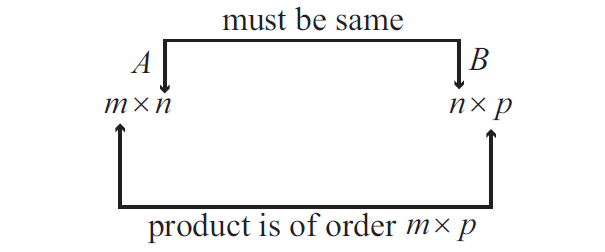OPERATIONS ON MATRICES
Subscribe to our ▶️ YouTube channel 🔴 for the latest videos, updates, and tips.
We have the following operations on matrices.
(i) Multiplication of a matrix by a scalar.
(ii) Addition and subtraction of two matrices.
(iii) Multiplication of two matrices.
Multiplication of a Matrix by a Scalar
Let A be a matrix and k be a scalar. The, we can define a new matrix kA by multiplying each element of the matric A by k.
For instance, if
In particular, if k = -1, then we have
kA = -A
This -A is called negative of the matrix A. Don’t say -A as a negative matrix.
Addition and Subtraction of Two Matrices
If A and B are two matrices of the same order, then their sum denoted by A + B, is again a matrix of same order, obtained by adding the corresponding entries of A and B.
Similarly subtraction A - B is defined as
A - B = A + (-1)B
Note :
(i) A + B and A - B are not defined., if A and B are not of the same order, then
(ii) The addition and subtraction can be extended to any finite number of matrices.
Example 1 :
Compute A + B and A - B, if
Solution :
By the definitions of addition and subtraction of matrices, we have
A + B :
A - B :
Example 2 :
Find the sum A + B + C if A, B and C are given by
Solution :
Example 3 :
Determine 3A + 4B - C if A, B, and C are given by
Solution :
Example 4 :
Simplify.
Solution :
Multiplication of Two Matrices
A matrix A is said to be conformable for multiplication with a matrix B if the number of columns of A is equal to the number of rows of B.
Let A be a matrix of order mxn and B be a matrix of order nxp.
Then the product of matrices A and B is denoted by AB and its order is mxp.
The order of AB is
mxp = (number of rows of A) X (number of ncolumns of B)

For example, if A be a matrix of order 1x3 and B be a matrix of order 3x1, then AB is a matrix of order 1x1, that gives a element.
For instance,
Example 6 :
Find AB and BA if they exist, if
Solution :
The order of A is 3x3 and the order of B is 3x2.
Number of columns of A is 3 and number of rows of B is 3.
number of columns of A = number of rows of B
So, the product AB exists and the order of AB is 3x2.
The product BA does not exist, because
number of columns of A ≠ number of rows of B
Matrix Multiplication is Not Commutative
For two matrices A and B, even if AB and BA are defined, then AB = BA is not necessarily true.
For instance, we consider
From (1) and (2) above,
AB ≠ BA
Properties of Matrix Addition and Scalar Multiplication
Let A, B, and C be three matrices of same order which are conformable for addition and a, b be two scalars. Then we have the following :
(1) A + B yields a matrix of the same order
(2) A + B = B + A (Matrix addition is commutative)
(3) (A + B) + C = A + (B + C) (Matrix addition is associative)
(4) A + O = O + A = A (O is additive identity)
(5) A + (-A) = O = (-A) + A (-A is the additive inverse of A)
(6) (a + b)A = aA + bA and a(A + B) = aA + aB
(7) a(bA) =(ab)A, 1A = A and 0A = O.
Properties of Matrix Multiplication
Using the algebraic properties of matrices we have,
(i) If A, B, and C are three matrices of orders mxn, nxp and pxq respectively, then A(BC) and (AB)C are matrices of same order mxq and
A(BC) = (AB)C
(Matrix multiplication is associative)
(ii) If A, B, and C are three matrices of orders mxn, nxp, and nxp respectively, then A(B + C) and AB + AC are matrices of the same order mxp and
A(B + C) = AB + AC
(Matrix multiplication is left distributive over addition)
(iii) If A, B, and C are three matrices of orders mxn, mxn, and nxp respectively, then (A + B)C and AC + BC are matrices of the same order mxp and
(A + B)C = AC + BC
(Matrix multiplication is right distributive over addition)
(iv) If A, B are two matrices of orders mxn and nxp respectively and α is scalar, then
α(AB) = A(αB) = (αA)B
is a matrix of order mxp.
(v) If I is the unit matrix, then
AI = IA = A
(I is called multiplicative identity)
Subscribe to our ▶️ YouTube channel 🔴 for the latest videos, updates, and tips.
Kindly mail your feedback to v4formath@gmail.com
We always appreciate your feedback.
About Us | Contact Us | Privacy Policy
©All rights reserved. onlinemath4all.com
Recent Articles
-
US Common Core K-12 Curriculum Algebra Word Problems
Dec 20, 25 01:19 AM
US Common Core K-12 Curriculum Algebra Word Problems on Systems of LInear Equations -
US Common Core K-12 Curriculum Algebra Solving Systems of Equations
Dec 20, 25 01:18 AM
US Common Core K-12 Curriculum - Algebra : Solving Systems of Linear Equations -
10 Hard SAT Math Questions (Part - 40)
Dec 18, 25 06:27 PM
10 Hard SAT Math Questions (Part - 40)
